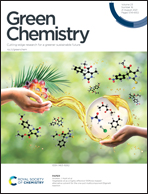Selective separation of lactic, malic, and tartaric acids based on the hydrophobic deep eutectic solvents of terpenes and amides†
Abstract
Inspired by traditional solvents for carboxylic acid extraction being not environmentally friendly, novel hydrophobic deep eutectic solvents (DESs) based on amides as hydrogen bond acceptors (HBAs) and terpenes as hydrogen bond donors (HBDs) were proposed as sustainable solvents. The structures were characterized by 1H NMR and GC-MS, meanwhile the formation mechanism was revealed by electrostatic potential (ESP) analysis. In addition, the partition coefficients and separation factors of lactic, malic, and tartaric acids (LA, MA, and TA) in novel DESs were tested by a simple solvent extraction approach. What's more, the contributions of HBAs and HBDs in improving the selective separation of carboxylic acids were confirmed by multiscale exploration and experimental research. HBAs increase the partition coefficient via forming double hydrogen bonds with LA, MA, and TA. HBDs improve the selectivity by competition with these acids. This finding can serve as a blueprint for the design of greener solvents for the selective separation of carboxylic acids in bioprocesses.



 Please wait while we load your content...
Please wait while we load your content...